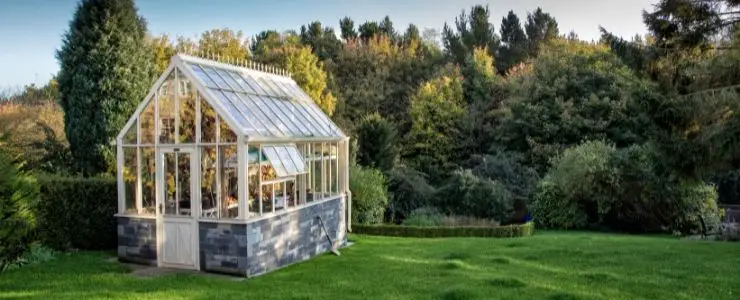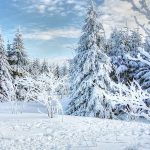Having a greenhouse can be a rewarding experience, and it doesn’t just come to use during the spring! A greenhouse can be used to grow big, beautiful plants and vegetables all year round. But what plants do you grow in the summer? This post will take a look at what to grow in a greenhouse in summer?
There are a variety of plants that can be grown in a greenhouse during the summer but they will need some ventilation. Some popular choices include tomatoes, peppers, cucumbers, and flowers. Tomatoes are a great choice for summer greenhouse gardening because they thrive in hot weather.
Growing the right plants in your summer greenhouse can give you a few extra especially well-nourished veggies come harvesting time. We will look at what are some of the best and most popular herbs and vegetables to grow in your greenhouse this summer, keep reading to learn more.
Growing Vegetables and Herbs in a Greenhouse in Summer
Growing vegetables and herbs in a greenhouse in summer is a great way to supplement your healthy eating. It’s much easier to grow vegetables in a greenhouse as temperature, bugs, and watering can all be controlled much easier than outside.
Peak summer sun can be overpowering for some plants and vegetables, consider how much sun does a greenhouse need here
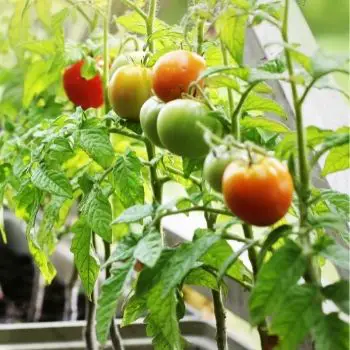
This can make for a great yield and a healthier meal – who doesn’t want that?
If you are wondering what to plant this summer then this list of common vegetables and herbs for growing in a greenhouse over summer is a great starter for you.
Get Your Summer Greenhouse Seeds
If you are looking to start planting then consider picking up some of these seeds to get your summer garden growing. (Amazon seed links below)
Herbs
Some herbs grow in hot or dry climates, making them ideal for the conditions inside of a summer greenhouse. Some of them are for taste, some of them are for smell, and some can do both! This list of summer greenhouse herbs will get your imagination going and give you some hints on what to grow this summer.
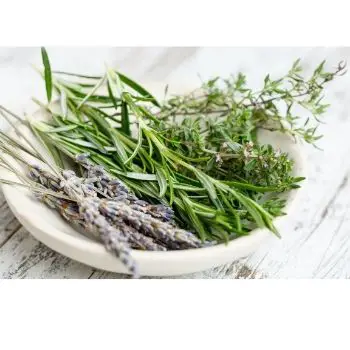
Lavender
The smell of lavender is absolutely delightful. I would describe it as sort of a mellow vanilla smell with a kick of pollen mixed in. It strikes the nostrils with a force like no other, and if you tend it enough, it can leave you smelling like it for hours!
Lavender is often grown in the warmer climates of places like southern France, and will absolutely flourish in a summer greenhouse.
For a real treat, dry out lavender petals and use them in your tea. To be honest, they don’t taste as good as they smell. They’re a little bitter, actually. But with honey, you can drown it out. And the aroma they produce will add to your teatime experience.
- Lavender Seeds (Amazon link)
Basil
Growing up, I used to eat basil from the garden straight off the stock. If you’re looking to do this, sweet basil might be your best bet. Sweet basil comes on strong and dies off with a sweet, oniony taste. That’s not to say it tastes like onions- that’s just what the taste reminds me of.
Basil grows great in the warmer temperatures of your greenhouse and will adore the sun. Not to mention, basil always seems to be one of those plants that get too much attention from caterpillars and pests. I can’t pick a basil leaf without finding a little hole in it somewhere.
In a greenhouse, you delete some of the need to protect your plants from harmful insects. Fewer insects mean fewer insecticides and other nasty things. Fewer chemicals mean a more natural, organic crop.
- Basil Seeds (Amazon link)
Oregano
Oregano is a fragrant, strong herb that can be mixed in with everything from rice to meat dishes. Oregano is often used in Italian and Latin cooking and can be eaten straight off the stem.
There’s an age-old saying with oregano that can be applied to many things- in general, people either love it, or they hate it. It’s a very strong taste, almost to the point of being pushy. Too much of it, and it can completely take over whatever dish your making. Make sure you know what you’re getting into before you commit to a shelf full of Oregano.
- Oregano Seeds (Amazon link)
Mint
Mint. Is. Spectacular. I can’t put it emphatically enough. Many people don’t like the taste of mint straight off the stem, but it has a myriad of uses besides being eaten raw. I like to mix mint into my tea, and in lemonade, it provides a strong, sugary taste with an added kick.
Mint tastes like heaven. Of course, this is just my humble opinion, but I can fully recommend growing it and tasting it for yourself. It grows like it’s got nothing better to do, and is an easy plant for people with a not-so-green thumb. Just tasting a leaf of mint seems to give me a bit of a head high- it really is that good.

Mint is basically the ideal greenhouse plant. It loves warmth, likes sun but will tolerate some shade, and will grow like wildfire. Keeping it in a greenhouse may indeed be your best bet if you want to keep it from taking over your whole garden bed.
- Mint Seeds (Amazon link)
Stevia
Wherever basil will grow, stevia will too. Stevia likes warm temperatures and will thrive if you give it the right care and attention. I’ve even known stevia plants to grow without a lick of attention- needing only the natural rain and soil we had on our property.
Stevia is a great mixer for everything from lemonade to alcoholic drinks. If you’re watching your sugar intake, stevia can be a great substitute. Straight from the garden, it tastes almost sweeter than sugar, and its leaves are a real treat to eat.
I would highly recommend plants like stevia and mint to people with children. Stronger, umami plants like basil and oregano can repulse children, but sweeter plants are a great way to get them interested in plants and gardening. It’s what attracted me as a child!
- Stevia Seeds (Amazon link)
Hot Peppers
Never doubt the power of a little hot pepper plant. Hot pepper plants will grow like nobody’s business if given the chance and yield edible, spicy veggies almost effortlessly. They have seemingly infinite uses and can be grown in the hot conditions of a greenhouse.
Habaneros are another great choice for those looking to grow a spicy veggie in their greenhouse. Habaneros are incredibly strong and spicy and will add a kick to any food. Not to mention, it’s easy to extract the seeds for another year’s growth.
The humble jalapeno. Jalapenos grow spectacularly well- and oh man- do they kick. Eating one straight is like receiving a swift slap to the face. They go great on nachos, in stews, and chopped up as a taco topping. Drying them out is easy and fun, and will give you a nice cupboard spice.
- Hot Peppers Seeds (Amazon link)
- Jalapeno seeds (Amazon link)
- Habanero seeds (Amazon link)
Eggplant

Eggplant is built for the heat. Eggplants are a nice, heat-loving plants that will supply you with hearty vegetables for use in any number of recipes.
When I was a kid, my mother used to take the eggplants from our garden and use them in eggplant parmesan. They’ve got a savory taste- almost meaty- but they get juicy like nobody’s business when you put them in the oven for a while.
Eggplants are the garden gift that keeps on giving.
- Eggplant Seeds (Amazon link)
Melons
Everyone loves a melon. From watermelons to cantaloupes, people eat melons like there’s no other fruit in the world. And they grow spectacularly well in the warm environment of a summer greenhouse.
Melons are useful in any number of dishes- from fruit salads to fruit bowls. We like to save our watermelons for harvesting on a single day, and invite all our friends over for a watermelon party.
Combine with other fruiting plants (most of which will grow exceedingly well in a greenhouse) and you’ve got a recipe for greatness on your hands.
- Watermelon Seeds (Amazon link)
- Cantaloupe Seeds (Amazon link)
- Honeydew Seeds (Amazon link)
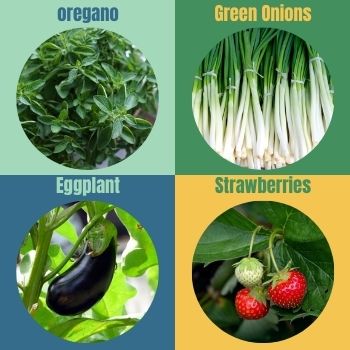
Strawberries
We know strawberries for their fickle taste in temperatures. Around where my family and I live, they throw a yearly strawberry festival- no doubt because if you get them to actually grow there’s some celebrating in order.
Strawberries will die like flies at the sight of one little frost- but did you know that they love to bathe in the heat and light? The conditions of a greenhouse appeal perfectly to a strawberry’s sensibilities, and can make for a great crop come harvesting time.
So long as strawberries have a constant temperature, I’ve found you can grow them effortlessly.
I would recommend strawberries because their potential uses are endless. I grow a few pounds of strawberries every year- not in a greenhouse, mind you- and while they spoil relatively quickly, I’m still using them all year round. I’ve got a dehydrator that I use to dry them out. Once dried, I mix them into my cereals for a touch of sugary sweetness.
The kids like to eat them too, which is better than seeing them chow down on a bag of potato chips (yuck).
- Strawberries Seeds (Amazon link)
Salad Greens and Microgreens
This is what I mainly use my greenhouse for. in any given year, I can get just about a hundred bags of microgreens out of my greenhouse. They love the warmth and the light, and oh boy, do they grow.
When I tell people this, they usually don’t believe me- but microgreens only take about two to three weeks to grow to full maturity. Start your beds at different times, and you’ll have a harvest coming around just about every week.
I grow arugula in my greenhouse, and it grows just spectacularly. I’ve got quite the square footage, so I can’t promise you’ll be able to grow like I do, but I can eat a salad made of my microgreens just about every day. They’re easy, cheap as dirt, and just plain know no bounds when it comes to growing.
Not to mention, they’re a good low-calorie option for anyone looking to lose a few pounds. A microgreen salad is something you might find at an expensive restaurant, and is nourishing and, as I’ve found out, filling too! If you’re just starting with a greenhouse, I’d definitely recommend growing as much salad and microgreens as humanly possible.
- Microgreens Seeds (Amazon link)
Green Onions
I put green onions on just about everything. Really, it’s almost shameful. My wife keeps telling me to get a little more creative- but I can’t help myself. They’re tangy, crunchy, and put the finishing touches on just about any dish.
Green onions will grow spectacularly well in the hot and humid environment of a summer greenhouse and don’t take much love and attention to really get going. Just water them when you can, give them a light space to grow- and they’ll treat you right. These are another plant you can dry and keep all year long, using them again and again in all sorts of dishes.
- Green Onions Seeds (Amazon link)
Can you grow tomatoes in a greenhouse in the summer
Yes, you can grow tomatoes in a greenhouse in the summer. Greenhouses provide a controlled environment that is ideal for tomato plants. Growing tomatoes in a greenhouse in summer is a great idea!

The warm temperatures and high humidity levels inside a greenhouse help the plants to thrive. In addition, greenhouses protect the plants from strong winds and heavy rains. As a result, tomato plants grown in a greenhouse are more likely to produce large, juicy fruits.
However, it is important to keep the greenhouse well-ventilated to prevent the plants from overheating. Tomatoes grown in a greenhouse may also require more watering than those grown outdoors.
- Tomatoes Seeds (Amazon link)
Do greenhouses get too hot in summer
When thinking about what to grow in a greenhouse in summer, the heat has to be something that needs to be taken into account.
Greenhouses are designed to trap heat and create a warm, humid environment that is ideal for growing plants.
However, in the summer months, the sun’s rays can cause the temperature inside a greenhouse to rise to dangerous levels. If the temperature gets too high, it can damage plants and even cause them to die.
To prevent this from happening, greenhouses are equipped with ventilation systems that help to regulate the temperature. In addition, gardeners can take measures to cool their greenhouses down, such as shading the windows or misting the plants with water.
By taking these steps, they can ensure that their greenhouse stays at a comfortable temperature all year round.
Can you grow vegetables in a greenhouse in the summer
You can grow vegetables in a greenhouse in the summer. In fact, many gardeners find that their greenhouse plants thrive during the hotter months. By Traping heat in the greenhouse, you can create a microclimate that is perfect for heat-loving vegetables such as tomatoes and peppers.
The key is to make sure that your greenhouse is well-ventilated and that the plants are getting enough water. If you can provide these two things, then you’ll likely have success growing vegetables in your greenhouse all summer long.
What can I grow in a small greenhouse in summer
Growing in a greenhouse in summer is the perfect time to start a garden in a small greenhouse. With the right plants, you can create a cool, shady retreat from the summer heat. Here are some of the best plants for a summer greenhouse:
1. Cucumbers – Cucumbers love the warm, humid conditions of a greenhouse. They will need support as they grow, so make sure to provide them with a trellis or other structure to climb.
2. Eggplants – Like cucumbers, eggplants thrive in warm, humid conditions. They also require support as they grow and produce fruit.
3. Tomatoes – Tomatoes are another heat-loving plant that does well in a greenhouse. Make sure to provide lots of support for them, as they will grow tall.
Related article:
What Makes a Summer Greenhouse So Special
Now that you know what types of plants will grow in a summer greenhouse, you’re likely wondering what it is that makes a summer greenhouse special. Why can’t you grow any old plants? Why should you stick to these?
Well, if you’ve ever been outside on a hot summer day, you know how unbearable temperatures can get. And with your greenhouse trapping those temperatures and circulating them around, it can see temps of a hundred degrees or more.
The heat will put your plants under some stress.
Tropical and heat-loving plants are bred especially for high temperatures and humidity and can take some dry soil conditions. These characteristics are essential for plants growing in the conditions of a summer greenhouse.
Summer greenhouses aren’t like open summer air. They get the same amount of light, but the heat trapped inside can get to be unbearable for many plants. Some plants are specifically adapted to this environment, and will actually grow better than if you had them outside. The plants we’ve listed are like this.
Greenhouses are also optimal because they largely protect from pests like rodents and bugs. Out in the open, you’ll likely have to share your delicious tomatoes with everything from caterpillars to fruit flies to deer. In a greenhouse, however, you’re safe.
Feel free to deviate from our list, there are many other heat-loving plants and vegetables you can grow in your greenhouse over summer. Be sure to select only plants that are adapted to hot environments. Plants that withstand high temperatures, dry soil, and high humidity will, in general, thrive in a greenhouse.
Conclusion
So, What to Grow in a Greenhouse in Summer? If you’re looking to grow plants in a summer garden, you’re best to stick to more heat-tolerant variants. Plants like tomatoes, peppers, and melons will be great, but there are plenty of veggies you can pull off with the right preparation and care.

